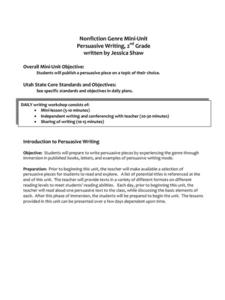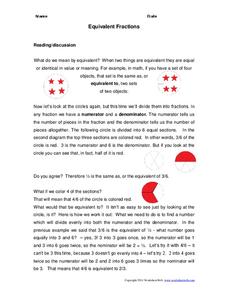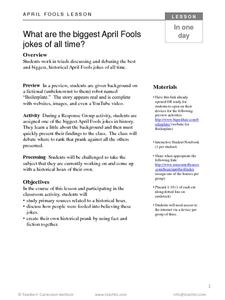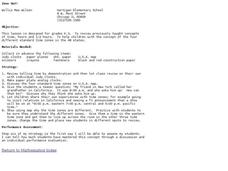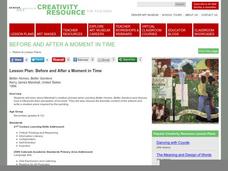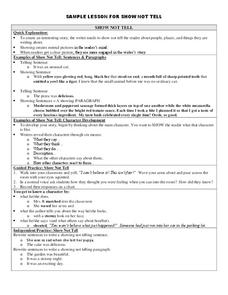National Wildlife Federation
Citizen Science to the Rescue!
You don't have to be a scientist or even out of high school to contribute to scientific research. In the 12th lesson plan in the series of 21, scholars use this opportunity to add to the growing body of scientific knowledge and consider...
Curated OER
Nonfiction Genre Mini-Unit: Persuasive Writing
Should primary graders have their own computers? Should animals be kept in captivity? Young writers learn how to develop and support a claim in this short unit on persuasive writing.
Intel
What Does This Graph Tell You?
What can math say about natural phenomena? The fifth STEM lesson in this project-based learning series asks collaborative groups to choose a phenomenon of interest and design an experiment to simulate the phenomenon. After collecting...
Curated OER
An Introduction to the Relationship Between Composition and Content in the Visual Arts
Students investigate how artists create a story that provides a message or provokes emotions in a single image. The ways in which the composition of a painting contributes to telling the story or conveying the message is examined in this...
Worksheet Web
Equivalent Fractions
Learn how to identify equivalent fractions by using divisors. After reading and discussing the skill, young mathematicians solve two problems using visual fraction models, and then solve eight equivalent fraction problems...
TCI
What Are the Biggest April Fools Jokes of All Time?
After working in groups to analyze primary sources related to a historical hoax, learners will discuss how people managed to be fooled and work to identify one of the biggest April Fools jokes in history.
Curated OER
"It's More Than a School": Proposing Programs to Meet Student Needs
This detailed lesson plan from New York Times' The Learning Network centers around Carroll Academy and its girl's basketball team. Learners compare their school to Carroll Academy, read anywhere from 1 to 5 engaging articles about the...
Constitutional Rights Foundation
Ellis Island—The “Golden Door” to America
Are you one of the 100 million Americans whose ancestors passed through the doors of Ellis Island? Learn about the historic entry point for immigrants in the late 19th and early 20th centuries with an informative reading passage. After...
Minnesota Literacy Council
Introduction to Historical Thinking
Christopher Columbus: hero or villain? Prepare class members for the debate with activities that asks them to think critically about how history is reported.
Curated OER
How to Build an Electric Motor
Sixth graders build a working motor. In this lesson on motors, 6th graders use an inquiry method of learning to discover how to create a working electric motor with the supplies given to them. The teacher will guide them as needed....
Alabama Learning Exchange
Mr. Crocodile's Busy Day
Demonstrate how to read analog and digital clocks to the hour in this time measurement lesson. Read the book What Time is it Mr. Crocodile? and use Mr. Crocodile's schedule to practice telling time. They work in cooperative groups to...
Curated OER
Making Time Real for Students
By using some real life examples students can better understand the concept of time.
The New York Times
650 Prompts for Narrative and Personal Writing
An extensive list of narrative prompts is just what you need to inspire young writers to tell their stories. Arranged by topic, the questions are sure give them something to talk about.
Benjamin Franklin Tercentenary
Benjamin Franklin and Learning a Lesson
Examine stories with a moral in a character development instructional activity. The class reads a short story written by Benjamin Franklin in which he pays too much for a toy whistle. Individuals then make text-to-self connections and...
Museum of the American Revolution
Historical Analysis: Objects Tell Stories
Dig this! Young archeologists discover what objects teach us about the past. The activity uses an image of a Revolutionary War artifact to help historians practice analyzing the past. Scholars study the object and complete a worksheet to...
Curated OER
Learning About Prepositional Phrases
What is a prepositional phrase? Read through the first page of your packet to give your budding grammarians a better sense of what a prepositional phrase is. Then, have them complete the two activities provided. The first asks them to...
Curated OER
Zone Out!
Students review telling time to the hour and half hour on an analog clock. In this time lesson, the students learn how to determine the time in each of the 4 standard time zones.
Curated OER
Face The Facts To Remember
Second graders use manipulatives, drawings, and story problems to learn the two's multiplication tables. After learning how to find answers, they participate in a memory game to match facts and answers.
Curated OER
STDs: You Have to Know
Students learn how to protect themselves from STDs. In this healthy living lesson, students define the acronyms for various STDs, work in groups to fill out charts on the most common STDs, and learn the five things they need to...
Curated OER
Just a Minute!
Students put the standard measure of clock time -- the minute -- in perspective. This lesson can be modified for virtually any grade level. They write about what they learned about a minute as a result of the activities.
Curated OER
Lesson Plan: Before and After a Moment in Time
Think about a moment, frozen in time. Now take a critical look at the painting, Better, Homes, Better Gardens. This painting works to provide learners the opportunity to analyze art, critique artist's choices, and write a story inspired...
Curated OER
Strategies to Build Comprehension Skills
Reading strategies that realy work. Here is an introduction of six active reading strategies to improve reading comprehension. Super helpful for newer teachers.
Curated OER
Show Not Tell
Middle schoolers learn to show, not tell, in their narrative writing. A slide show takes them through the process of choosing strong, descriptive words, and then provides writing prompts for them to use as practice. The first two pages...
American Museum of Natural History
Mint Your Own Coin
Provide young archaeologists with an opportunity to craft their own artifacts. The step-by-step directions in an engaging resource show them how to mint their own coin, complete with image, date, and motto.

